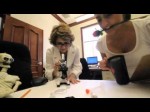There is exciting new hope on the horizon for the treatment of combat-related trauma, and I feel that I have had a front-row seat in watching this ground-breaking and hopeful solution to one of our country’s most heart-breaking problems — Post Traumatic Stress Disorder (PTSD) in the military. Let me elaborate. As a psychoanalyst, I had the pleasure of attending a conference in Los Angeles that highlighted the work of Dr. Russell Carr, a naval psychiatrist who heads up inpatient psychiatry at the National Naval Medical Center in Bethesda, Md. Dr. Carr has spent a decade in military campaigns since 9/11 in both Iraq and Afghanistan. With this experience of his, if anyone can empathize with and develop ways to effectively treat PTSD in military personnel, I believe that Dr. Carr can. But before he was able to do this, first he had to look for ways to help himself. In an attempt to survive and to tolerate his own shattering experiences with war, Dr. Carr read widely, seeking knowledge from various areas in psychology and psychoanalysis. Although drawn to psychoanalysis, Dr. Carr found that psychoanalytic theory and treatments were not specifically developed to address problems that arise in adulthood, such as the effects of combat on soldiers; that is, until he discovered the work of famed Los Angeles psychoanalyst, Dr. Robert Stolorow. When he discovered Dr. Stolorow’s book, “Trauma and Human Existence” in 2008 while he was still in Iraq, Dr. Carr carried the book around with him all the time, squeezing every bit of knowledge out of it that he could: Stolorow’s book was more like a companion in the darkness of trauma, helping me to understand and bear the experiences of being in a combat zone. Otherwise, I was left in my isolation, only with answers that seemed to blame my childhood fantasies about my parents for the mortars exploding outside my office. Dr. Carr feels that his adoption of Stolorow’s ideas has saved both him and his patients from the isolation and despair of living in a shattered experiential world following combat. He began to shift his stance from a more intellectual understanding of the patient’s mind to one of empathic introspection on his part that follows along with the patient’s feelings. Dr. Carr strives to provide what Stolorow calls a relational home between two human beings in a therapeutic relationship, for those “wounded warriors” who are dealing with massive issues of guilt, shame and mortality. So just how does this approach work in ways that manualized cognitive-behavioral methods don’t? Instead of adopting a stance of “here’s your problem and here’s how to fix it,” Dr. Carr helps his patients to feel that they are coming up with solutions that fit their unique situations, allowing them to feel safe and trusting in the relationship, as they develop the ability to find words to describe their experience. The patient hopefully can feel a profound sense of being “found,” and of having their traumatic reactions witnessed. It is that process that leads to recovery. Another important aspect of treatment is the illumination of the patient’s shattered sense of innocence and illusions about life in general. Because we are all finite beings over whom death and loss constantly loom, Stolorow theorizes that human beings develop what he calls the absolutisms of everyday life . This means we all develop unquestioned beliefs and assumptions that we unconsciously live by, in order to flee from the uncertainties of life and to maintain a sense of continuity, predictability and safety. For example, when you say to a loved one, “I’ll see you tomorrow,” it is taken for granted that both you and the other person are going to be around. Stolorow writes, “It is in the essence of emotional trauma that it shatters these absolutisms, a catastrophic loss of innocence that permanently alters one’s sense of being-in-the-world.” (Stolorow, “Trauma and Human Existence”) When we can no longer believe in such “absolutisms of everyday life,” many of us feel that the universe becomes unpredictable, random, and unsafe, and it is especially traumatizing when this loss echoes what happened to us in childhood. But can you imagine how these absolutisms are destroyed completely for warriors who are confronted day after day with a dangerous world that threatens their very existence, and even their memory of a safer world? Because of this shattering of the illusions of safety, often traumatized people see the world differently than others do. They feel anxious, alienated and estranged in an unsafe world in which anything can happen at any time. Anxiety slips into panic when it has to be borne in isolation. In the absence of a sustaining relational home where feelings can be verbalized, understood, and held, emotional pain can become a source of unbearable shame and self-loathing. Therefore, this feeling of alone-ness is exactly what happens to wounded warriors, who are at great risk of falling into the grip of an impossible requirement to “get over it.” Could anybody ever imagine John Wayne developing PTSD and — even worse — admitting that he needed to seek help for it? Using an in-depth case example of a patient he calls “Major B,” Dr. Carr was able to impress upon the audience the complexity of the experiential world of a severely traumatized Major in the Air Force, as they worked together on the critical issues of guilt and shame. For Major B, it is not the violence he witnessed in Afghanistan that haunts him; it is his feelings about the violence he inflicted. He often maintained that, given the circumstances again, he would kill the same people, but that doesn’t make it any more bearable. He has nightmares in which he can’t stop killing people, and, seeing himself as an emotionless “killing machine,” he’s afraid that he won’t recognize the difference between what is normal and what is a threat. According to Stolorow, when these unendurable emotions cannot be processed with others, these feelings become dissociated and the individual feels a sense of deadness, dullness and a loss of vitality, and it becomes difficult to feel any connection with other human beings. As if these feelings of guilt were not difficult enough, the feelings of shame are even more painful. The worst part for Major B was his feeling that he couldn’t handle combat and that he needed help with the unbearable emotions from it. Before he met Dr. Carr, he believed he could not seek out other people to help him bear and process his feelings about killing large numbers of people. In his mind, he was supposed to maintain the persona of the stoic tough guy whom nothing bothered. Before he began to wrestle with the emasculating experience of admitting to his problems, and then seeking help, he turned to “Dr. Alcohol” and the comforting thought of committing suicide as antidotes to the feeling that he had lost his mind in Afghanistan. Dr. Carr states: By providing a relational home to the traumatic experiences of many combat veterans, I understand the guilt and shame that many of them feel. I understand why some severely traumatized veterans feel as if they deserve to die, why they feel more at ease sleeping under a bridge than rejoining the communities they fought to defend. And through my work, I understand better my own feelings of alienation from the rest of America after participating in a decade of military campaigns since 9/11. I feel profoundly privileged to have witnessed this important event in which the field of psychoanalysis has broken ground in the treatment of military personnel. Dr. Carr, whom I consider to be a national treasure, received a tearful and extended standing ovation from a large and seasoned group of psychoanalysts, who never imagined that the words “military” and “psychoanalysis” would be uttered in the same sentence! My hope is that Dr. Carr’s work will receive the acknowledgement it deserves, and that his methods can be implemented throughout the military to bring our wounded warriors the sense of hope that many of them have lost. See the original post: Helen Davey: Inside The Mind Of A War Vet







